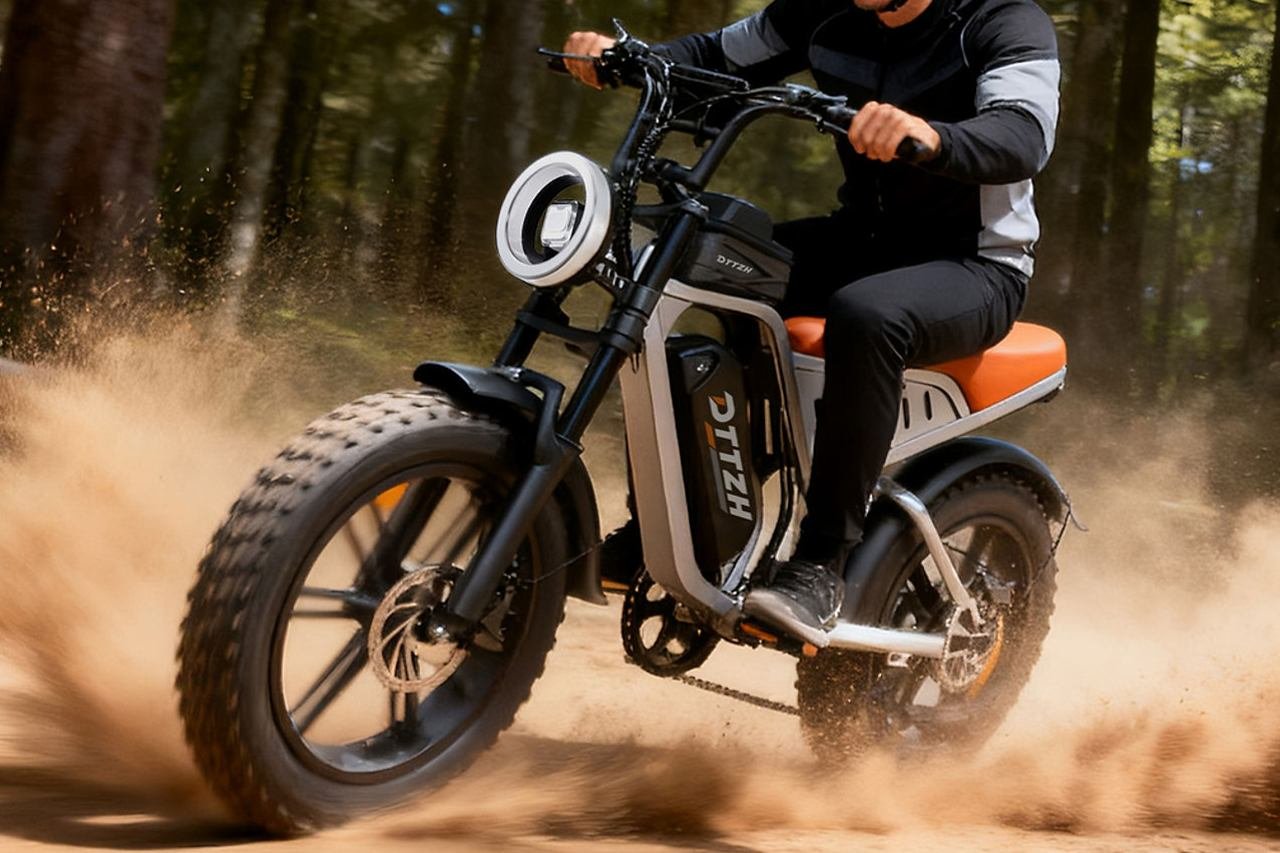
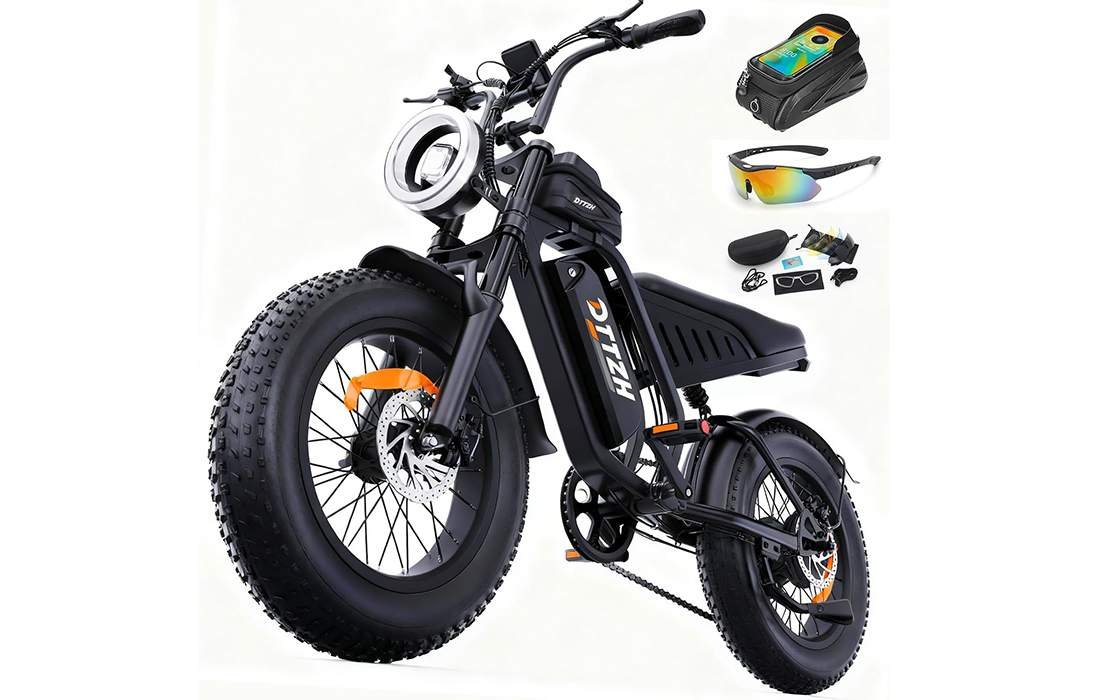
DTTZH F6 — Tap-to-Unlock Mini-Moto for Daily Rides
NFC/password unlock, 1500W peak motor and 48V 15Ah battery. Full suspension + 20×4" tires keep city-to-trail rides smooth.
- NFC + password unlock—shareable, no keys needed
- 750W rated (1500W peak) hub; strong hill starts
- 48V 15Ah removable + 3A fast charge (5–7h)
- Motor
- 750W (1500W peak)
- Battery
- 48V 15Ah
- Top Speed
- Up to 33 mph*
- Range
- Up to 60 miles PAS
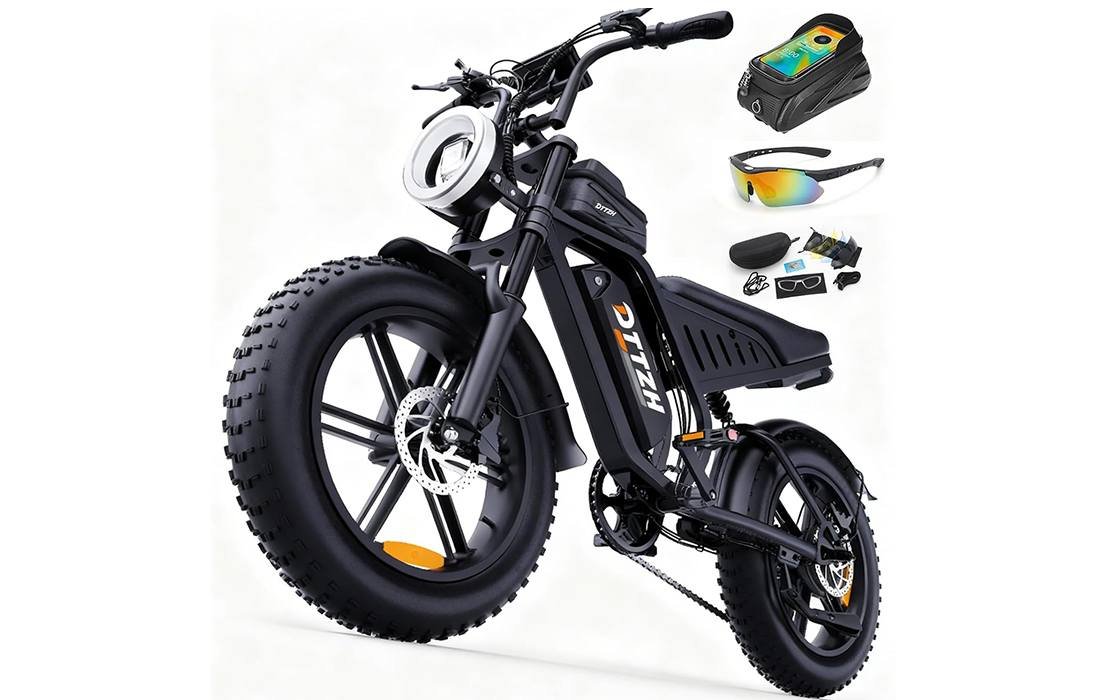
DTTZH F6S — 2000W Peak, Long-Range & Hydraulic Brakes
48V 25Ah battery, 1000W rated (2000W peak) hub and hydraulic discs push the compact platform into true hill-climbing territory.
- 1000W rated (2000W peak) hub; confident 35° climbs
- 48V 25Ah pack; up to 80 miles PAS range
- Hydraulic discs + 4" color LCD + NFC/password
- Motor
- 1000W (2000W peak)
- Battery
- 48V 25Ah
- Top Speed
- Up to 40 mph*
- Range
- Up to 80 miles PAS
The DTTZH F6 is one of those “why didn’t they do this sooner?” e-bikes: a compact, moped-style frame with legit trail manners, a motor that actually pulls on hills, and a clever key-free lock system so you can hop on and go. The brand sells two trims that look almost identical at first glance—F6 and F6S—but they’re tuned for slightly different riders.
The F6 pairs a 750W rated (1500W peak) hub with a 48V 15Ah battery for quick, punchy riding up to a claimed 33 mph (unlocked, off-street). The F6S ups the ante with a 1000W rated (2000W peak) hub, 48V 25Ah battery, hydraulic brakes, and a higher claimed 40 mph top end (again: unlocked, off-street). Both ship with 20×4 in fat tires, full suspension, and the standout NFC card + password unlock—no jangly keys in your pocket, no tiny barrel locks to fumble with.
If you’ve been looking at “mini motorcycle” e-bikes and you’re wondering which ones offer real power without a boutique price tag, the F6/F6S duo is firmly in that conversation. After spending time riding both trims on city streets, gravel connectors, and a few dusty service roads, I came away impressed with the value—and clear on who should buy which.
Is DTTZH F6/F6S for you?
The F6 family solves a familiar problem: you want motorcycle vibes and hill-climbing grunt, but you don’t want to live with a full-size 26–28" frame or spend four figures on a premium brand. The compact 20" fat-tire platform gives you low standover height and a relaxed, upright cockpit; paired with front and rear suspension, it takes the sting out of potholes, washboard gravel, and curb hops. Both trims are beginner-friendly: the throttle is progressive, the display is simple, and that NFC/password system keeps things easy when you share the bike with family members.
Who’s it for? Riders who commute a mix of city streets and rougher shortcuts, apartment dwellers who want the smaller footprint of a 20" bike, and weekend explorers who want to climb hills without walking. If you value practicality, the F6 is the more everyday-friendly trim—lighter battery, quicker charge, plenty of speed for urban use. If you crave power, carry a heavier rider, live in hilly country, or want maximum range for long days, the F6S is the better match thanks to more motor and a much larger 25Ah pack.
Who should pass? If you’re chasing the agile feel of a traditional bicycle, the long seat and moped geometry won’t feel as “bike-y.” If local rules cap you at Class 2 or Class 3 speeds, you’ll need to keep the bike in the legal settings (the default is 20 mph), and the over-40-mph marketing won’t matter. If you haul cargo daily, the lack of a factory rear rack means you’ll be doing some aftermarket fitting.
Price-wise, the F6 family sits in the budget-to-mid tier for this category. That’s where its strongest appeal lies: real power, dual suspension, and a big battery option for hundreds less than many competitors.
What We Like About the DTTZH F6/F6S
First, the unlock experience is genuinely delightful. Tap the NFC card or punch a four-digit code and you’re rolling—no fumbling for a key when your hands are gloved, and no worries about snapping a barrel lock off the battery. It sounds small, but when you ride every day it’s the kind of polish you notice.
Second, the motors deliver the goods. The F6’s 750W rated hub punches above its rating off the line, and on mellow hills I could keep pace with traffic without dipping past PAS 4. The F6S takes that sensation and turns it into “I have headroom in reserve”—on a private test stretch, acceleration stayed strong well past the speeds where many 20" bikes start to feel “out of gear.” On both trims, torque is sufficient that you don’t need to plan a running start for hills, and the bikes feel unfussed on uneven ground.
I also rate the comfort package highly. The suspension fork and rear shock aren’t boutique components, but they soak up the chatter that typically fatigues riders on concrete seams or brick pavers. The 20×4" tires provide both grip and a big air volume cushion, and the long bench seat lets you scoot forward to push into corners or slide back for straight-line cruising. It’s a “ride farther than you intended” kind of comfort.
Battery experience is better than the spec sheet suggests. On the F6, the 3A charger actually matters: topping a 15Ah pack in 5–7 hours is realistic, so an empty-to-evening refill is doable. On the F6S, the 25Ah pack is a lot of battery for the money. Paired with conservative PAS, it stretches range into “day trip” territory. The UL 2849 safety note is reassuring, especially for apartment riders and anyone storing the bike indoors.
Lastly, DTTZH nails the approachability. The color LCD is bright in sun, the PAS levels are intuitive, and the 7-speed drivetrain allows normal-cadence pedaling into the upper-20s before ghost-spin sets in. Assembly is quick (both are shipped ~95% complete), and the out-of-box fit is broadly accommodating for a range of rider heights.
What We Don’t Like About the DTTZH F6/F6S
No surprise: weight. Like most moped-style fat-tire bikes, the F6 and F6S are not friendly for walk-ups beyond a short flight of stairs. The big battery and steel hardware add up. If you have to carry the bike daily, look elsewhere.
Brakes are the other differentiator—and potential downside on the base trim. The F6S ships with hydraulic discs and lots of power; the F6 is typically sold with mechanical discs, which are usable but require more hand force and careful setup to avoid rub. If you plan to ride near the top of the speed range, I strongly prefer the F6S for the braking package alone.
The seat is a comfort win for short hops, but the single-height bench offers limited adjustability for long-legged riders who want an efficient pedal stroke. That’s part of the moped aesthetic, but it’s still a trade-off. Similarly, the frame lacks built-in provisions for a rear rack or panniers; yes, you can fit universal mounts, but you’ll need to get crafty if you want a clean cargo solution.
Finally, top-speed marketing on any 20" mini-moto bike should be read with context. The F6’s claimed 33 mph and the F6S’s 40 mph are realistic only in unlocked settings and best-case conditions. Many riders will keep the bike class-legal at 20–28 mph, which is where the bikes feel most composed anyway. Call it a power reserve rather than an everyday target.
Pros & Cons
| Pros | Cons |
|---|---|
| Key-free NFC + password unlock is fast and practical | Heavy; not fun to carry upstairs |
| Real hill-climbing torque; F6S has serious punch | Mechanical brakes on F6 require a strong hand and more tuning |
| Full suspension + 20×4" tires = comfortable on rough city streets | Bench seat limits pedal ergonomics and height adjustability |
| Two battery options: quick-charge 15Ah or long-range 25Ah | No factory rear rack; cargo requires aftermarket improvising |
| Bright color LCD, intuitive PAS, 7-speed drivetrain | Claimed 33–40 mph only in unlocked mode; consider local laws |
| UL 2849 safety compliance for peace of mind | Larger 25Ah pack takes 8–10 hours to fully charge |
| Strong value in the budget-to-mid price tier |
What’s Included?
- DTTZH F6 or F6S e-bike (95% pre-assembled)
- 48V removable battery (15Ah on F6, 25Ah on F6S)
- 3A fast charger
- Two NFC smart keys/cards
- Integrated color LCD display
- Front suspension fork and rear shock (pre-installed)
- Front and rear fenders
- LED headlight and rear light (with brake function)
- 7-speed drivetrain and pedals
- Basic multi-tool / hardware kit
- Printed owner’s manual and quick-start sheet
- (Often included by seller) Top-tube phone bag, sports sunglasses, and a small accessory pack—these extras can vary by listing
I’m satisfied with the out-of-box kit. You have everything required to ride, including the practical pieces (fenders, lights). The NFC cards are a pleasant bonus, and the fast charger is the right pairing for these packs. My “wish it had” list is short: a bolt-on rear rack, and on the base F6, hydraulic brakes. You can upgrade later, but I’d gladly pay a small premium to have those parts stock.
Technical Specifications
| Category | DTTZH F6 | DTTZH F6S |
|---|---|---|
| Motor | 750W rated hub, 1500W peak | 1000W rated hub, 2000W peak |
| Top Speed (unlocked, off-street) | Up to 33 mph (default 20 mph) | Up to 40 mph (default 20 mph) |
| Battery | 48V 15Ah removable | 48V 25Ah removable |
| Charger | 3A fast charger, ~5–7 h | 3A charger, ~8–10 h |
| Claimed Range | Up to 60 miles PAS | Up to 80 miles PAS |
| Torque (claimed) | ~60 Nm | ~80 Nm |
| Tires | 20×4.0 in fat tires | 20×4.0 in fat tires |
| Suspension | Front fork + rear shock | Front fork + rear shock |
| Brakes | Mechanical disc (typical) | Hydraulic disc |
| Drivetrain | 7-speed | 7-speed |
| Display | Color LCD | Larger 4" color LCD |
| Security | NFC card + password unlock | NFC card + password unlock |
| Safety | UL 2849 / GCC stated | UL 2849 / GCC stated |
| Riding Modes | Throttle, PAS, Manual | Throttle, PAS, Manual |
| Assembly | 95% pre-built | 95% pre-built |
Features
- NFC + Password Unlock: Tap and go, or share a 4-digit code with family—no physical key required.
- Two Power Options: 1500W peak (F6) for everyday riding; 2000W peak (F6S) for bigger riders, steeper terrain, and higher speeds on private property.
- Big-Volume Batteries: 48V 15Ah or 25Ah packs with a 3A charger to minimize downtime.
- Full Suspension + 20×4" Tires: Comfort and traction on streets, gravel connectors, and light dirt.
- 7-Speed Drivetrain: Keeps cadence reasonable from neighborhood speeds into the upper-20s.
- Hydraulic Brakes on F6S: Shorter stopping distances and lighter lever feel.
- Bright Color LCD: Speed, PAS level, battery bars/voltage, trip metrics in sunlight-readable format.
- UL 2849 Compliance: Added confidence for indoor storage and regular charging.
- Three Riding Modes: Throttle-only for relaxed cruising, PAS for range efficiency, and manual if you want a workout home.
- 95% Pre-Assembled: Straightforward setup; you’ll typically mount the front wheel, handlebar, and pedals.
How do the features land in real use? The power systems are the story. On the F6, PAS 3–4 feels like the “daily sweet spot,” delivering mid-20s cruising without drawing the battery down too quickly. The F6S shifts the curve upward—PAS 3 is already brisk, and PAS 5 keeps pulling where many 20" bikes flatten out. The suspension is tuned for comfort, not aggressive jumping; think “float through potholes” rather than “soak a 3-foot drop.” The 7-speed drivetrain is mainly there to keep legs engaged; above the high-20s you’ll start to spin out, which is normal for a 20" wheelbase. And that NFC/password system? It becomes second nature after your first week—tap, beep, ride.
Real-World Riding Notes
Fit & Ergonomics. The long bench seat and relatively tall bars position you upright with good visibility. Short riders can put both feet down at stops; taller riders may wish for extra seat height to get a more extended leg on the downstroke. The cockpit is wide enough to feel in control on loose surfaces without the twitchiness that plagues some compact frames.
Acceleration & Hill Climbing. From a dead stop, both trims step out cleanly—no jolting spike, just a smooth build as the controller feeds current. On moderate grades (the kind that makes a casual rider sweat), the F6 holds speed in PAS 4 with light pedaling. The F6S is a different animal: add a little throttle on steep county hills and it shrugs off pitches that would stall lesser hubs. If you’re a 200-lb rider or you carry a backpack full of work gear, you’ll appreciate the headroom.
Handling. Fat 20" tires are inherently stable at urban speeds and downright planted on dirt. The compact wheelbase changes lines quickly—easy to navigate bollards and squeeze through stopped traffic—yet the mass down low keeps the bike from feeling skittish. The suspension keeps the tires tracking on choppy surfaces; dialing a few clicks of preload on the rear shock helped the bike resist wallow when accelerating out of turns.
Braking. This is where the twins diverge most. The F6’s mechanical discs work, but they require a firm squeeze, especially on descents. Plan your stopping distances. The F6S’s hydraulics feel like a class upgrade—one-finger braking at city speeds, with a strong initial bite and less fade after repeated hard stops. If you ride in hilly areas, the difference is worth the money.
Range. Numbers always depend on rider weight, wind, temperature, and how much throttle you use. With mixed urban riding and conservative PAS, the F6’s 15Ah battery is a comfortable commuter pack—recharge every 2–3 rides. The F6S’s 25Ah pack is a day-trip pack; if you ride mostly PAS at sub-25 mph, you can plan long loops without range anxiety. The ability to fully recharge overnight with a 3A brick means you’re ready again the next morning.
Noise & Vibration. Hub whine is present under hard acceleration but never intrusive. Chain slap is minimal thanks to the shorter chain run. The plastic fenders can rattle on washboard if the mounting bolts aren’t snug—check them after the first few rides.
Lighting & Visibility. The integrated headlight is bright enough for suburban streets and to be seen in traffic. The rear light’s brake function is a plus. I added a helmet-mounted flasher for extra conspicuity on fast roads; the battery’s USB charging port is handy for topping up accessories at rest stops.
Maintenance. Hub-drive simplicity is a big part of the appeal here. Keep the chain clean, check spoke tension periodically (fat tires + torque means it matters), and re-center those mechanical calipers if you ride the base F6. The open layout makes routine stuff easy without pulling bodywork.
Which One Should You Buy?
- Choose the F6 if you want an approachable, budget-minded mini-moto that still climbs hills and keeps an honest 20–28 mph pace in legal modes. It’s the “ride every day and charge quickly” trim, and it’s easier on the wallet.
- Choose the F6S if you weigh more, ride steeper terrain, want hydraulic brakes from day one, or care deeply about long-range days. The bigger motor and battery aren’t just numbers—they change the way the bike feels on sustained hills and high-speed connectors.
If your riding is mostly urban with short dirt connectors and you don’t exceed Class-legal speeds, the F6 gets my nod as the best value. If your riding mixes big climbs, long distances, or frequent high-speed runs on private property, the F6S earns its keep.
Safety & Legal Notes
Out of the box, both trims ship with a 20 mph limit that matches common Class-2 rules. The higher top-speed claims require unlocking (and, in some regions, push the bike outside e-bike classifications).
Ride within local laws. More power also means more responsibility: practice emergency stops in a parking lot, keep two fingers on the brakes in traffic, and consider upgrading to stickier tires if you ride wet weather frequently.
Upgrades I’d Consider
- Hydraulic brakes (if you buy the F6). It’s the single best upgrade for confidence at speed.
- Rear rack + soft panniers. A universal moped rack or seat-rail solution turns the bike into a weekday hauler.
- Suspension seatpost or gel pad if you do long pavement days—the bench is comfy but not plush.
- Mirrors and bell/horn for dense city streets.
- Tire sealant (or tough tubes) to reduce flats on goat-head-prone trails.
The Competition
Plenty of 20×4" mini-moto e-bikes promise big speed. Where DTTZH wins is the unlock system and value equation.
You can certainly spend more for premium suspension and branded brakes, or less for smaller batteries and weaker motors.
The F6/F6S sit in a sweet spot: real-world power and creature comforts without the premium tax.
Final Breakdown
9.0 / 10
The DTTZH F6 family nails the brief. It looks the part, it rides with conviction, and it layers in thoughtful quality-of-life features—most notably the NFC + password unlock and a fast charger that keeps downtime short. The base F6 is the value hero for everyday riders; the F6S is the torque-rich long-range sibling that feels overbuilt in the best way. Neither is perfect: weight is real, a rear rack should be standard, and I wish hydraulic brakes were universal across trims. But taken as a whole—motor strength, suspension comfort, battery choices, safety compliance—the package is easy to recommend. If you want a compact e-moto that climbs, cruises, and turns heads on a budget, start your shortlist here.
Recommendation:
- Everyday commuter and mixed-surface riders: Buy the F6.
- Heavier riders, steep-hill locals, or long-range explorers: Buy the F6S.
Ride safe, set your speed to match local rules, and enjoy the freedom of tap-to-unlock.


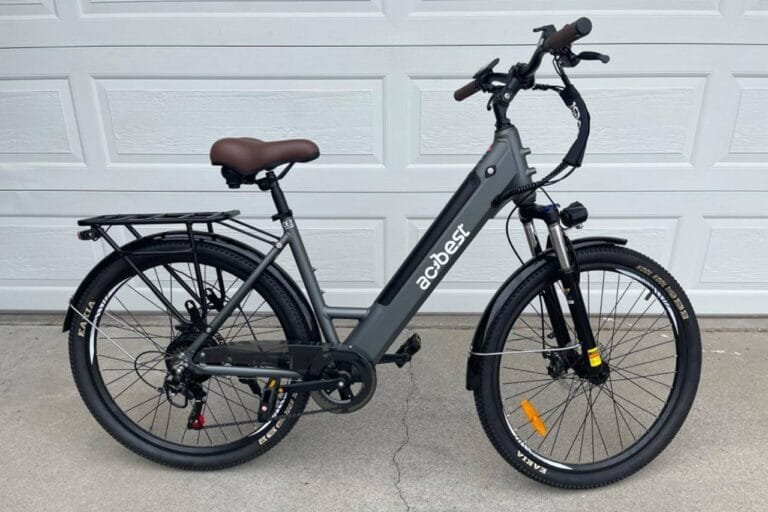
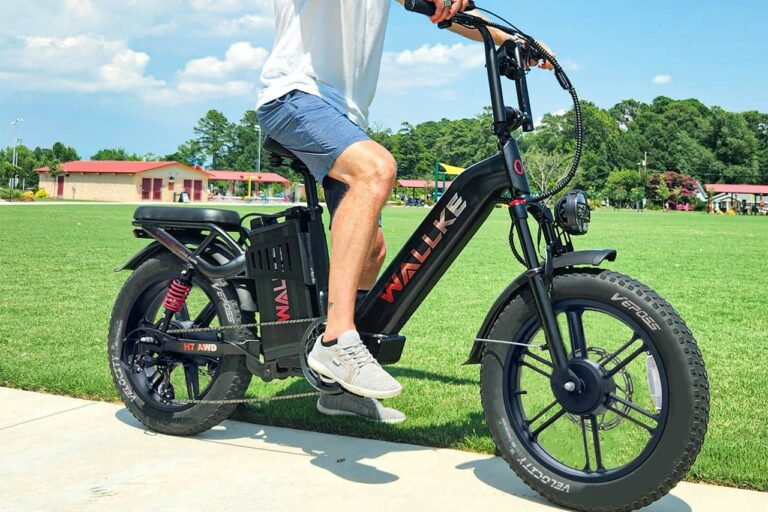
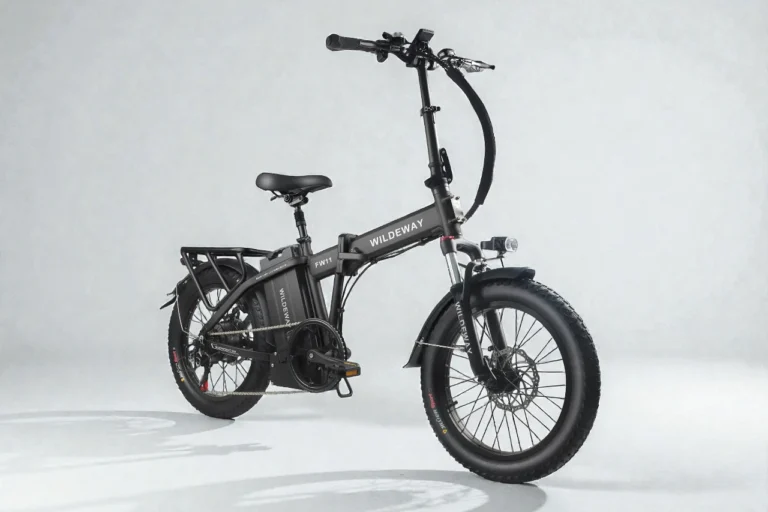

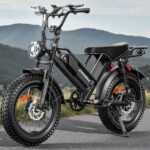
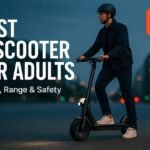
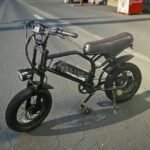
Rear rack + soft panniers. A universal moped rack or seat-rail solution turns the bike into a weekday hauler.
What would you recommend. Bought the bike but no idea on how to go about this.
Hi Austin — great idea. A rear rack + soft panniers really does turn the F6/F6S into a weekday hauler.
My go-to setup (easy and solid):
Why this combo? It avoids drilling or special mounts, keeps clear of the fat tire, and balances weight nicely.
Quick install (10–15 minutes):
Quick tips: Keep total load under the rack’s rating, mount bags low/forward for balance, use a drop of threadlocker on bolts, and re-torque straps/bolts after a few rides.
Enjoy the new bike!